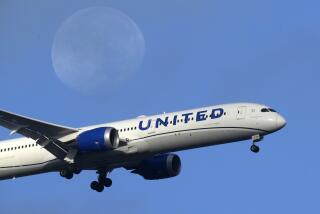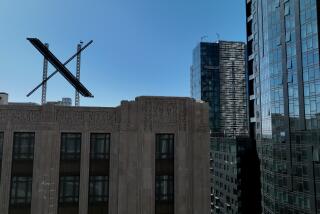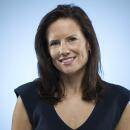San Francisco plane crash: Onlookers stunned, stranded, delayed
As a large passenger jet lost its tail and skidded on its belly at San Francisco International Airport on Saturday, many travelers watched, stunned, from the huge windows inside a terminal.
Waiting to board her flight to Phoenix, Krista Seiden saw the Asiana Boeing 777 hit the ground and slide along the tarmac before turning into “billowing smoke.” She exclaimed to those around her: “A plane just crashed!”
The startled agent at the US Airways counter said: “What? Are you sure?” and immediately picked up her phone.
Seiden, a 26-year-old high-tech marketing manager from San Francisco, pulled out her smartphone, photographed the smoky scene hundreds of yards away and tweeted to her followers: “Omg a plane just crashed at SFO on landing as I’m boarding my plane.”
Twitter erupted with messages from shocked witnesses. Travelers walked in disbelief to the windows, asking one another what just happened. Was it two planes colliding? One? A woman worried aloud about her boyfriend, whose flight had just left.
On the tarmac, Red Neri, 41, and his wife, Lynne, 43, were aboard United Airlines Flight 885 bound for Osaka, Japan, when the Asiana jetliner came hurtling down the adjacent runway.
“It sounded like a sonic boom,” said Red Neri, who lives in Livermore and was leaving on vacation.
The commuter operations manager said he glimpsed the face of a flight attendant who had a better view of what was happening.
“She just kept saying, ‘Oh, my God, oh, my God,’” said Neri, who ended up sitting on the plane for 31/2 hours before heading home.
Two Mexico City schoolteachers, headed for their honeymoon in Thailand (via Tokyo), also learned of the accident shortly before their scheduled takeoff.
The flight attendants sitting behind Caroline Horowitz and Leo Patino began to mutter to each other. Then the pilot turned on the loudspeaker.
The rumor, Horowitz recalled him saying, was that a plane had just crashed.
“You hear something like that, and all you can think is, ‘What?’” Horowitz said. “You need processing time.”
The man in the seat next to Horowitz found a YouTube video of the crash on Twitter, and the row watched it in silence.
For hours after the crash, emergency vehicles with lights flashing swarmed around the plane, which came to rest just off a runway. Several police boats sped through San Francisco Bay.
Inside the terminal, passengers were stranded for hours. They sat on suitcases and stood in line to charge cellphones and laptops at a sparse number of power outlets. Gate agents and airport personnel had little information about how long they might be stuck. Long lines formed as agents attempted to rebook passengers on Sunday and Monday flights.
Many travelers gave up and left the airport.
Hugo Jimenez waited for five hours Saturday with his wife and three daughters for a Delta flight to Tokyo. The family from Mexico City, looking dazed, rebooked for Sunday and left in search of a hotel at 5 p.m.
“We haven’t even found one yet,” he said in Spanish. “We’re tired.”
One official at United announced over a loudspeaker that all flights coming in and out of San Francisco would be halted indefinitely. A Southwest agent told another passenger that flights were canceled for the day.
Not long after the crash, airport spokesman Doug Yakel said that flights were diverted to several other airports and that no planes would be allowed to land at or depart from the airport.
By midafternoon, however, two runways had reopened, and at least two large international jets and several smaller regional planes landed. Many areas of the airport were by then eerily devoid of passengers.
Electronic departure boards showed solid blocks of canceled flights for Saturday.
The plans of arriving passengers were disrupted as well.
Catherine Malone Habas and her family were 20 minutes from landing in San Francisco, on their way home from a two-week vacation in Cape Cod, when the plane unexpectedly began circling and the pilot came on the public-address system.
“He said, ‘Everything went smoothly for five hours and 40 minutes, but we’ve been put into a holding pattern for at least 20 minutes because of a disabled plane at SFO,’” Malone Habas recounted.
Twenty minutes later, the pilot came on again with the brief message that the flight was being diverted to Sacramento.
David Habas then looked at the television screen and saw that a plane had crashed less than 30 minutes earlier. The couple’s first thought was of their sons.
“The footage we were watching was live,” Malone Habas said. “We knew there had been a crash. We turned the screens off so our children, who are 8 and 5, wouldn’t become alarmed. Then we circled for a while before we could land in Sacramento, because other planes were doing the same thing.”
Once the plane got to the gate in Sacramento, it sat for half an hour before crew members arrived to help the passengers depart. People remained calm throughout the process, she said, and the pilot and flight attendants did not discuss the crash.
“But once we landed and could turn on our phones, there was the scramble for people to figure out how to get from Sacramento to the final destination,” said the public relations consultant, who lives with her family in the East Bay town of Lafayette.
Seiden, who watched the crash in horror from the San Francisco terminal, ultimately was able to board a plane to Arizona from Oakland.
With a pilot father and flight attendant mother, she said, she usually was not one to be rattled about flight problems.
“Not gonna lie, a bit freaked out before landing just now at Sky Harbor Airport in PHX,” she tweeted. “Thankfully was a safe landing!”
Times staff writers Laura J. Nelson and Maria La Ganga contributed to this report.
More to Read
Sign up for Essential California
The most important California stories and recommendations in your inbox every morning.
You may occasionally receive promotional content from the Los Angeles Times.













